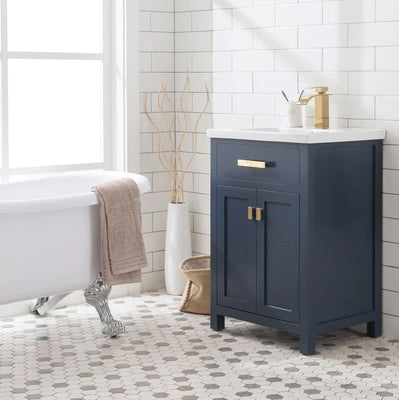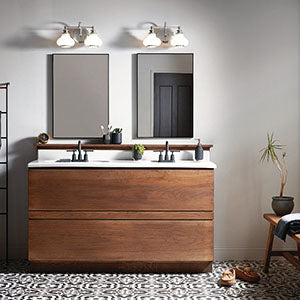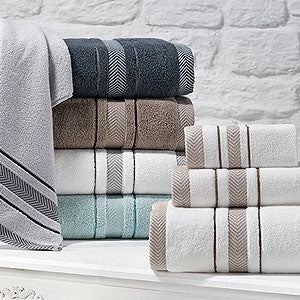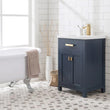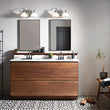Guide to Planning a Bathroom Remodel
Plan Ahead Before You Start
A bathroom remodel is not only an excellent way to spruce up your interior, but it also helps increase your home’s value at the same time with up to an 50%-70% return on investment* if you sell your home. The benefits of remodeling your bathroom are improved aesthetics, better safety, and increased comfort and functionality. A bathroom remodel can be as easy as a simple new coat of wall paint, some new fixtures, or a new sink. Or you can start with a clean slate and do a full gut and replacement on the shower, tile, flooring, vanity, toilet, etc. to give your bathroom an entirely new look. If your bathroom is dated from a previous decade, chances are it could use a full update.
On average, a full bathroom remodel can cost between $5,000 and $20,000 with labor cost accounting for up to 40%-65% of the budget**. A simple refresh may only cost your $200-$1,000. The more involved the project and more extensive the demo and rebuild needed, the more it will cost. Depending on your budget and time constraints, you may opt to do your remodel in stages or all at once. You may do all or portions of the work yourself or hire professionals for the complete project or just for the larger tasks. Preparing your remodel in advance will help you budget for the project, avoid unnecessary costs, and make smart decisions to help you get the bath of your dreams without breaking the bank.

Plan ahead to turn your bathroom design into the room of your dreams.
Draw Up Your Makeover Design
The first step in planning a bathroom remodel is to determine what your vision of the design is in terms of how you want the bathroom to look and function. The design should be able to fit a realistic budget and skillset if you plan on doing any or all of the work yourself. You can plan out the remodel yourself or enlist the help of design experts. To help you begin, here are some design elements you should think about when establishing what you will need to accomplish your bathroom makeover.
Extent of your remodel
Scope out how much you will be renovating. Will you be replacing your sink, vanity, toilet, tub, shower? Take the cost of these new items into account when planning your budget. Are you expanding a shower stall? Adding a freestanding tub? Does your flooring need replacing? Will you be adding architectural elements such as wainscoting, new window, door, and baseboard trim? Does your bathroom need to be gutted to the studs and new drywall installed? All these factors need to be determined in the planning stage.
Do-it-yourself or hire professionals
Assess your DIY skills along with the time and effort you are willing to put into doing the remodel yourself versus hiring professional bathroom contractors. Do you have the knowledge, tools, and experience to handle the job? Do you have the time and energy to deal with a remodel and your day job? Do you have the ability to deal with permits and inspections? Will the job look professional when done? Depending on your budget, if may make sense to hire out for some of the tasks while handling smaller ones like painting, sourcing and buying products, or even some of the demo yourself to save the money it would cost to have the contractor handle it.
Color scheme
Choose a color scheme that suits your tastes beginning with a main color along with accent colors to complement the overall look. You’ll need to consider color when choosing wall paint, tile, cabinetry, and textiles such as rugs, towels, and curtains, and wall décor. You don’t want your floor or shower tiles to clash with your paint color.
New fixtures
Are you replacing your sink and shower/tub fixtures? If so, determine what fixtures you need including rough-in valves if replacements are required. Many people also choose to coordinate bathroom accessories such as the towel bars, toilet paper holders, shower rods, robe hooks, grab bars, etc. with the finish and style of their plumbing fixtures for a more cohesive look. Make a list of what fixtures you need.
Location of utilities
Do you need to move or update electrical wiring or relocate plumbing pipes? Are you adding extra electrical wiring for towel warmers, baseboard heating, additional outlets, or radiant flooring? Make sure you have accurate measurements for electrical and plumbing and know if any need to be repaired or replaced during the remodel.
Lighting fixtures
Decide what lighting fixtures you will need along with location. Most bathrooms will need at minimum vanity lighting and an overhead ceiling light. Additional fixtures may include a shower ceiling light, ventilation fan, task, or accent lighting. For tips regarding bathroom lighting, check out our helpful articles in our Advice & Idea section.
Storage space
Where will you keep your bath linens, toiletries, and bathing essentials? Do you need to expand or add a closet, shelving, or cabinets to create new or additional storage space? Now’s the time to plan to add some storage and organization options even if they are as simple as some bathroom shower caddies or storage bins.
Determine the Cost Breakdown
Once you determine what you need or want to change in your bathroom, you can compile a list and total up the prices for the itemized elements along with costs for labor, supplies, and any design or installation fees. Add at least 10% to the total cost to budget for any unforeseeable issues or repairs that may come up as the project gets underway. The following estimated cost breakdown with percentage of overall budget and average total cost for each has been compiled by the National Kitchen and Bath Association for an $11,364 bathroom remodel in 2016:
- Installation: 20% ($2,273)
- Cabinetry/hardware: 16% ($1,818)
- Fixtures: 15% ($1,705)
- Faucets/plumbing: 14% ($1,591)
- Flooring: 9% ($1,023)
- Countertops: 7% ($795)
- Lighting/ventilation: 5% ($568)
- Walls/ceilings: 5% ($568)
- Doors/windows: 4% ($455)
- Design fees: 4% ($455)
- Other: 1% ($114)
Of course, the above costs are just one example, but it will give you a basis for knowing what to consider on your own remodel list along with ballpark costs to help you plan a budget. Doing part of the labor or sourcing out products yourself will save you money compared to hiring a bathroom remodel contractor to plan and implement the entire project. If hiring out professionals, be sure to get estimates from at least three different contractors to ensure a competitive price and check online sources and reviews before choosing a company.
Be Prepared for Inconvenience During the Remodel
If you have previously remodeled other rooms in your home, you know that even a small bathroom refresh will cause some inconvenience, mess, and chaos. If this is your first job, be aware that any makeover or construction will come with unavoidable issues during the project.
If your bathroom is undergoing a full renovation, you will need to locate alternative bathrooms to use on site or nearby during construction. If using a contractor, keep the lines of communication open so you are aware of any problems or delays and are on the same page when it comes to the timetable of each phase of the remodel. Knowing how the project is progressing and when your bathroom will be finished will help you cope with the disruption and inconvenience. For a full remodel, plan on an average of three weeks with an unusable bathroom.
Once you have a plan, budget, and contractor in place, you are ready to begin the remodel. Don’t forget to have fun picking out the fixtures, décor, and accessories. You are building your dream bath after all, so make sure you enjoy the process. The work, money, and hassle will definitely be worth it when you get to enjoy your beautiful new bathroom.
*Remodeling 2020 Cost vs. Value Report, 2017 NARI Remodeling Impact Report.
**According to Home Advisor.

